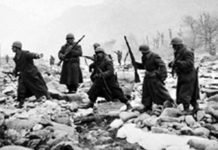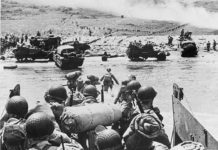During the Indian Wars, General George Crook was denied victory in the Battle of the Rosebud due to inaccurate presumptions and ineffective tactics.
The Battle of the Rosebud, fought on June 17, 1876, would lead to a defeat for General George Crook against the same warriors that would crush George Custer eight days later in the Battle of the Little Bighorn. It would also contribute to future warfare and government policy against the Sioux and Cheyenne nations.
That morning, after a surprise attack on Crook’s camp at Rosebud Creek, Crook ordered his forces to form a counterattack and repel the enemy. Based on bad intelligence and previously unseen ferocity exhibited by the warriors, Crook assumed the enemy had engaged to protect their nearby village. After neutralizing the enemy attack, Crook would proceed northward on Rosebud Creek to locate and destroy it.
Crook’s Battle Plan Thwarted
The Indians riding with Crazy Horse that day had different plans. Though Crook’s column totaled a massive 1,300 men, Crazy Horse intended to lure of them into the broken country surrounding the Rosebud by feigning retreat. In doing so, the rough terrain would naturally break the column into smaller and smaller groups. His warriors would then turn and destroy them one at a time in a manner similarly used during the Fetterman Massacre.
Crook initially fell into the trap. At the start of the Indian attack, he sent his various companies in different directions to secure the high ground. As the morning progressed, his right flank was successful at moving over several hilltops and driving the enemy back. He ordered his left flank under the command of Lt. Col. William B. Royall to do the same. Royall was not so fortunate. As Crazy Horse intended, the terrain through which Royall moved broke his command into several small groups and exposed them to counterattack. After distancing his men about a mile from the rest of Crook’s forces, Royall found himself surrounded.
As Royall struggled to defend his position, the fighting raged over the entire battlefield. Even General Crook himself was involved and had his horse shot out from beneath him. A female by the name of Buffalo Calf Robe Woman gained the respect of her people through an act of heroism. Her brother, Comes In Sight, was in grave danger after his horse was killed and he was left stranded on the battlefield. She moved in with her horse and carried him away from the nearby enemy. The engagement for the Cheyenne would become known as “Where the Girl Saved Her Brother.”
In Search of the Phantom Indian Village
Though Crook’s men were able drive the Sioux and Cheyenne back, the Indians continued regroup and resume their attacks. When Crook became frustrated with the lack of progress in the battle, he ordered Captains Anson Mills and Henry Noyes to take their cavalry down the Rosebud to locate and destroy the suspected Indian village. The civilian packers and miners accompanying the column replaced them to defend the right flank. Seeing part of the cavalry leave, the Indians on the right shifted to the left and focused their efforts on finishing Royall’s men.
Royall ordered his troopers to fall back to the safety of Crook’s main force as their losses continued to mount. According to Phineas Towne, the only man of one of Royall’s companies to survive the battle, “it seemed that if one Indian was shot five were there to take his place.” Had it not been for dozens of scouts and two companies of infantry sent to its relief, it is likely that Royall’s command would have been completely wiped out.
As Mills and Noyes followed the Rosebud, they were sent orders to return to the battlefield and assist Royall. He had made his way back to the main column by the time they arrived. Although they did not directly aid Royall in his relief, the return of Mills and Noyes did cause the warriors to withdraw from the battlefield and return to their village.
Crook’s casualties numbered 13 killed in action and 21 wounded. While only 13 Indian bodies were found, Crazy Horse later stated that his forces suffered 36 men killed and 63 wounded at the Rosebud. Casualties to the Sioux and Cheyenne could have been much higher. Prior to Crook’s offensive, he had decided to mark the friendly Indian scouts with red as a way to identify them. Unknown to the commander at the time, the Sioux dressed for battle in a manner very similar to the scouts. Troopers had difficulty distinguishing friend from foe during the engagement.








